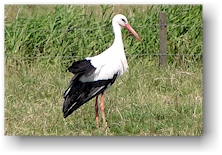|
» Knokke » Damse Vaart » Domain Ryckevelde » Leopoldcanal » Schipdonkcanal » NR town walls of Damme » NR fortress Saint-Donaas » NR Platte Kreek » Batreserve » Birdlife » NR Zwin |
Nature reserve "Het Zwin"
History of "het Zwin". If we have to stick an age to "het Zwin", then we can go back in time as far as we wish. In the soil, traces have been found that take us back to the Eocene (begin Tertiary, roughly 30 to 40 milion years ago). Let's keep it a little bit more contemporay and start with Tacitus, who described the landscape for Julius Ceasar. The coastal area here was a vast and practically impenetrable freshwater marsh in which the tribe of the Morines ruled. The Romans with their heavy equipment wisely stayed out of the swampy area. Dunes separated the sea and the marshland. One very important event for the region was the seatransgression of Dunkirk. It is most easily described as a series of massive invasions of the sea, flooding the lower lands during a longer period. When the sea retreated, sediments were deposited that form the actual soil of the fertile polders. A first invasion took place in the 2nd century BC and was not radical. The second one however (4th century), broke through the girdle of dunes more or less where the Zwin is right now. The seawater streamed inland and reached a small place that would later become one of the largest seaports in the world: Bruges. From the 8th century drainage started and slowly the sea was pushed back. The third phase of the transgression (10th century) was of utmost importance for Bruges, which had already become a major trade town. A storm in 1134 created a large channel that came very close to Bruges. On this place, Damme was founded. A canal was dug to link Damme with Bruges. In the 12th century, drainage of the grounds restarted. This created more land for farming but also narrowed the natural channel. It even influenced the working of tide and the strength of the current in the Zwin. Since the currents were less strong, more sediments were deposed which made the waterstream silt up which made Damme more and more difficult to reach for larger vessels. As a result, in the 14th centuy the center of trade shifted more towards north, making Sluis more and more important. A last period of drainage happened at the end of the 19th century. In 1872 the last piece of land was drained. Up till that moment the sea still reached Sluis.
A few historic
data: The Zwin at present The Zwin is the only place on the Belgian coast where you still have the natural sequence of sea - beach - dunes - marshland - grassland. This combination is the base for a large diversity of plant- and wildlife. A still quite substantial girdle of dunes separates the nature reserve of the Zwin with the seaside community of Knokke (le Zoute). This area is accessible for cyclists and stollers (stay on the paths though!). The Zwin itself is partially located on Dutch and partially on Belgian territory. It consists of a birdpark, a part of the reserve that is accessible to the public and a protected area (nesting grounds etc.). The reserve has an acreage of about 150 ha. Flora
The composition of the soil in the
Zwin is very variated: salty marshland and dry grounds. A
hard environment to survive, even for plants. A number of
species however are very well adapted and only thrive here and
nowhere else in Belgium. Birdlife
The
Zwin is most known for its rich diversity of birds. More than half of all
the species recorded in Belgium can be found here. The
reasons for this are multiple. Here you have a transition
between sea and land housing both sea- as landbirds. The
sea deposits large quantities of food (plankton, molluscs,
crustaceans,...) on a daily basis; the higher areas are an ideal
nesting ground safe from predators and water. You have to
take into account that a lot of the birds are migratory birds,
so their presence depends on the time of the year. The
most well-known flying friends of the Zwin are the storks (Ciconia Ciconia).
This beautiful big bird was extinct in the area but due to a
successful breeding programme, they can often be noticed again.
|
|
 This
old nature reserve is not in Damme but in the neighbouring
community of
This
old nature reserve is not in Damme but in the neighbouring
community of 